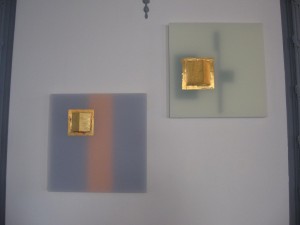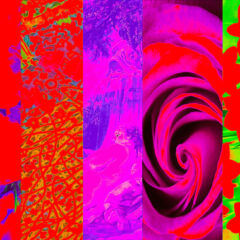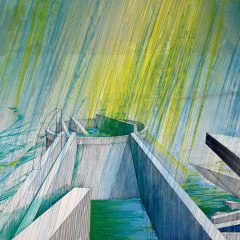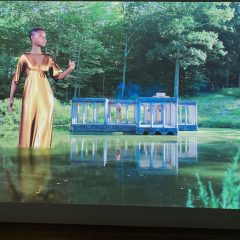A house is not necessarily a home, nor is it necessarily an art gallery. But of three shows up right now in spaces originally meant for living, two of take advantage of the space in which they are showing, playing off the domestic and architectural spaces.
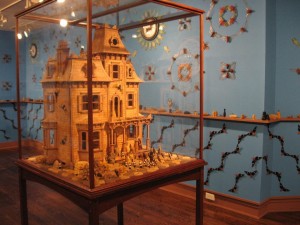
One of those two shows is The Sitting Room: 4 Studies at the Philadelphia Art Alliance. Taking the show’s mission and turning it into their own meditation on life and meaning, artists Jennifer Angus, Ligia Bouton, Carole Loeffler and Saya Woolfalk took a rather literary approach with implied narratives.
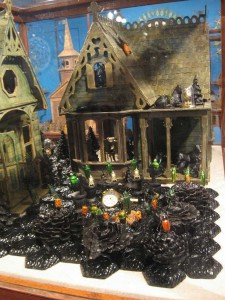
Angus and Bouton stick closest to their Victorian setting. Angus takes an A.S. Byatt-ish delight in insects. She pins enormous insect carapaces to the walls to create wallpaper-like patterns. She peoples Victorian-style dollhouses in vitrines with smaller insects, which play the role of armies of people, children, and families amid dollhouse furniture. The tiny, tiny architectural model figures of people become the caged pets of the insects in Angus’ dollhouse scenarios, which also include cast beeswax cakes, animals and trees.The takeaway from this is how teeming our planet is with life, production and death, an untamable life cycle that overwhelms all attempts to civilize or limit with patterns, cages, or social niceties.
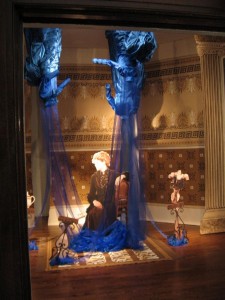
Bouton takes over three rooms with her Victorian ghosts and mediums. Sticking to a palette of brown lifesize cutout cardboard figures and electric-blue fabrics and thread, she suggests ghosts by hanging stuffed Victorian blue dresses upside down from the ceiling. (I presume she made these dresses; they are beauties). A sampler in an embroidery hoop held by one of the cut-out figures becomes the screen for a trio of ghostly musicians. Another cut-out woman emits threads that become blue gloves imprisoning a cut-out man in an armchair. In this world, it’s the ghosts and the women/mediums who have the real power, the full color, the sense of life. The domain of the sitting room in Bouton’s work is a space where women and their values dominate.
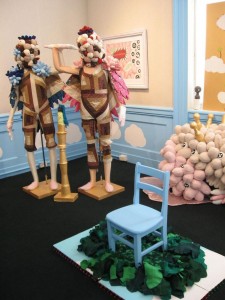
Woolfalk inhabits one of the first-floor sitting rooms with life-size fabric dolls–Raggedy Ann and Andy for a great new society. Woolfalk delivers a message of a post-racial-identity future. The video on an HD television above the mantle looked to me like the same one she showed at Nexus last year, and I think many of the props she used were video props. The vision of vivid stuffed polyps and willful futuristic teens and parents created a physical confrontation with my own drabness and propriety. Woolfalk brings to the future a nonstop Candyland sense of decoration that is anti-Victorian and empowered.The optimism and ebullience and belief in recycling and a transformed human race seems naive, but it’s a story we all want to hear amid a troupe of dolls we all want to hug–sort of.
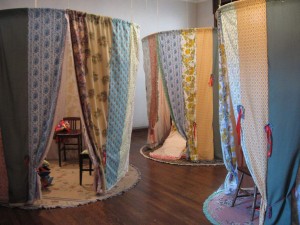 The weakest of the installations is a group of drapery enclosed, cabana-like spaces by Carole Loeffler, with altered chairs inside, floating atop rugs, disconnected, emitting creaky noises. I gotta say I did not get this.
The weakest of the installations is a group of drapery enclosed, cabana-like spaces by Carole Loeffler, with altered chairs inside, floating atop rugs, disconnected, emitting creaky noises. I gotta say I did not get this.
The show will remain at the Philadelphia Art Alliance to Jan. 3, 2011.
While we’re on the subject of interiors and sitting rooms, Jacque Liu’s 16 minimalist objects that merge opulent materials with oversized or abstracted architectural motifs look right at home in the downstairs parlors at City Space, a Center City realty office carved out of a gorgeous Victorian house. This is the space to where Michael Garden has moved his Area 919 operation. Liu’s materials, which include gold leaf, luminous frosty mylar, and paper, sometimes shout their presence, sometimes step back to become a supporting player for the setting. Accordian blinds go pink or gold, small or large. But they look great, sometimes barely breathing their presence on the walls. Some of the objects suggest spiritual luminscence and peacefulness–states of mind. Some look like floor plans. But then there are the giant moldings out of scale and out of place, awkward enough to evoke some humor, serious enough to earn the full gold treatment. The work is pure decor with a monastic aura.
Area 919 at City Space
2200 Walnut Street
9.29.2010 – 11.12.2010
Monday-Friday, 1-5PM or by appointment 215 500 2981
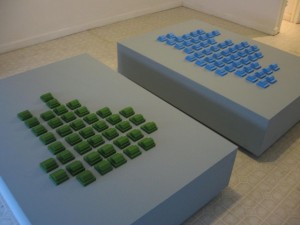
While these two shows play off the idea of living space and architecture, My House Gallery is just a space that happens to be in a home. Even after the departure of its spiritual genie Alex Gartelmann for grad school, I am happy to report My House continues to hold exhibitions, and Alex’s name remains on the team signature. The others running the gallery are Hannah Heffner, Fernando Ramos, Jim Grilli and Aidan Rich. The current show, Omega Point–Outward, includes sculpture, video, and 2-D from three artists–Andrew Geddes, Justin Rubich, and Brendan Sullivan. Geddes’ work stands out for its elegance and craftsmanship, 2-inch-ish identical forms arrayed in a grid that overwhelmingly suggests ticky-tacky suburban houses, a sort of tamped down and regulated Mark Campbell. Geddes’ forms are a little ambiguous, and their size and array are suggestive of toys, products and orderly ordinariness. The colors are spot-on lovely (and also suggest the idea of landscape colors in a meta sort of way). The idea of the outdoors and merchandise are displayed indoors in a rowhouse livingroom. Geddes’ fellow Baltimorean Brendan Sullivan offers several videos, including a number of vertical triptych videos with bands of words, imagery and sound. Although some of the imagery is intriguing, the whole was less than its parts. Philadelphia artist Justin Rubich’s paillette paintings (and also one a distribution chart made with marker) are pat, billboards meant to be taken in quickly. You get it then you’re done.
I had to know what Omega Point is, so I Googled my friend Wikipedia and found this: The Omega Point is a term coined by the French Jesuit Pierre Teilhard de Chardin (1881–1955) to denote the state of the maximum organized complexity (complexity combined with centrality), towards which the universe is evolving.
This did not enlighten me.
My House Gallery
September 17-October 31
2534 S. 8th Street


